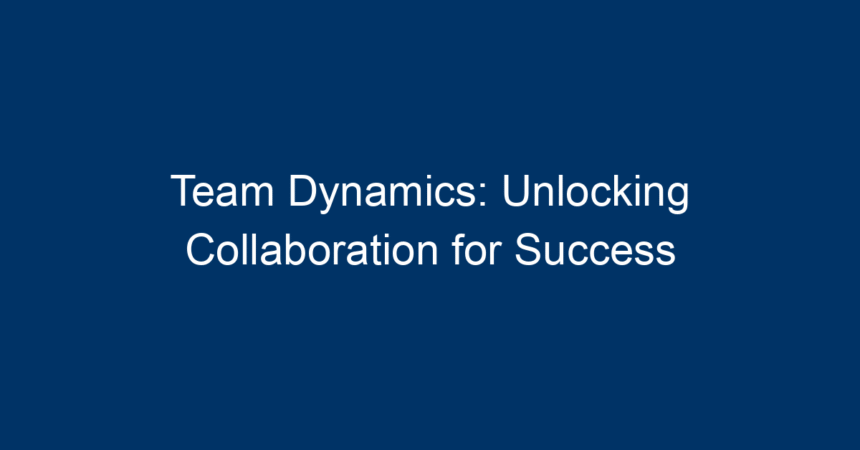In today’s fast-paced and interconnected world, the success of organizations hinges on effective team dynamics. The ability of a team to collaborate and communicate effectively can dramatically influence productivity, innovation, and overall success. Whether in a corporate setting, a nonprofit organization, or a sports team, understanding and optimizing team dynamics can unlock pathways to greater collaboration and achievement.
Understanding Team Dynamics
What Are Team Dynamics?
Team dynamics refer to the behavioral relationships between members of a team. These dynamics can either enhance or hinder the team’s ability to perform effectively. The concept encompasses various factors, including communication styles, conflict resolution strategies, and the roles individuals play within the group.
The Importance of Healthy Team Dynamics
Healthy team dynamics can lead to higher morale, increased collaboration, and improved problem-solving abilities. When team members feel supported and valued, they are more likely to contribute creatively and engage with their peers. Conversely, poor team dynamics can result in misunderstandings, conflicts, and decreased productivity.
Key Components of Team Dynamics
1. Communication
Effective communication is at the heart of successful team dynamics. It involves both sharing information and actively listening. Clear communication helps to establish trust, clarify expectations, and minimize misunderstandings.
Tips for Improving Communication:
- Encourage Open Dialogue: Create an environment where team members feel comfortable sharing their thoughts and feedback. Use regular check-ins to facilitate conversation.
- Utilize Technology: Tools like Slack, Microsoft Teams, or Zoom can aid in fostering clear communication, especially for remote teams.
- Active Listening: Encourage members to practice active listening by summarizing what others say to ensure understanding.
2. Trust and Respect
Trust is foundational to positive team dynamics. Team members must feel confident in each other’s capabilities and intentions. Respecting each individual’s contribution fosters a sense of belonging and commitment.
Building Trust and Respect:
- Lead by Example: Leaders should model trust and respect behaviors, showing vulnerability and admitting mistakes when necessary.
- Foster Inclusivity: Celebrate diverse perspectives and encourage participation from all members.
- Establish Clear Roles: Clearly define roles and responsibilities to reduce overlaps and tensions, allowing team members to know where they stand.
3. Conflict Resolution
Disagreements are inevitable in any team, but how they are handled can significantly impact team dynamics. Effective conflict resolution strategies can prevent issues from escalating and allow for more innovative solutions to emerge.
Strategies for Conflict Resolution:
- Address Issues Promptly: Don’t let conflicts fester. Address them as soon as they arise to foster a culture of resolution.
- Understand Different Perspectives: Encourage team members to express their viewpoints and seek to understand differing opinions.
- Collaborative Problem-Solving: Promote a solution-focused approach where team members work together to find resolutions.
4. Role Clarity
Clearly defined roles within a team are essential for maintaining effective team dynamics. When each member knows their responsibilities, it reduces confusion and overlap, allowing for more streamlined workflows.
Tips for Defining Roles:
- Role Assignments: Clearly assign roles and responsibilities during team meetings and document them for reference.
- Skill Utilization: Align tasks with individual strengths, ensuring everyone contributes effectively based on their expertise.
- Regular Role Reviews: Revisit role definitions as projects evolve to ensure they remain relevant.
Enhancing Team Dynamics
Setting Goals
Establishing clear goals is essential for guiding team efforts and measuring success. Goals provide direction and motivation, helping to align individual contributions with the larger mission.
Effective Goal-Setting Techniques:
- S.M.A.R.T. Goals: Ensure that goals are Specific, Measurable, Achievable, Relevant, and Time-bound.
- Collaborative Goal-Setting: Involve team members in the goal-setting process to foster ownership and commitment.
Building Team Culture
A positive team culture nurtures relationships and supports effective team dynamics. It’s the underlying environment that shapes how team members interact with each other.
Cultivating a Strong Team Culture:
- Team-Building Activities: Engage in activities outside the workplace to strengthen bonds and improve relationships.
- Celebrate Successes: Acknowledge both individual and collective accomplishments to foster a positive environment.
The Role of Leadership in Team Dynamics
Leadership Style
The leadership style adopted by team leaders significantly impacts team dynamics. An effective leader promotes collaboration and encourages employees to contribute their ideas.
Attributes of Effective Leaders:
- Empathy: A leader should understand the emotional needs of team members to foster trust and respect.
- Adaptability: Leaders should be flexible, adjusting their style based on team needs and dynamics.
- Clear Communication: Maintain transparency about decisions and changes to ensure everyone feels informed.
Measuring Team Dynamics
Assessing Effectiveness
Regularly evaluating the effectiveness of team dynamics is crucial for ongoing improvement. Surveys, feedback sessions, and performance metrics can provide valuable insights.
Evaluation Techniques:
- 360-Degree Feedback: Implement feedback from peers, subordinates, and supervisors to gauge team dynamics comprehensively.
- Team Health Checks: Conduct informal checks to discuss team morale, communication effectiveness, and any issues that may arise.
Continuous Improvement
Team dynamics are dynamic and can evolve over time. Always be on the lookout for opportunities to improve team interactions and relationships.
Actionable Insights for Teams
- Invest in Communication Tools: Leverage technology to enhance clarity and promote effective communication among team members.
- Promote a Culture of Trust: Foster an environment where trust thrives through transparency, inclusivity, and respect.
- Focus on Conflict Management: Equip team members with tools and techniques to manage conflicts effectively.
- Define Roles and Responsibilities: Clearly articulate what each team member is responsible for to eliminate confusion.
- Celebrate Diversity: Embrace the unique strengths and perspectives that each individual brings to the team.
Conclusion
In conclusion, optimizing team dynamics is essential for unlocking collaboration and achieving success. By focusing on components such as communication, trust, conflict resolution, role clarity, and leadership, organizations can enhance their team’s effectiveness. Remember, the journey of enhancing team dynamics is ongoing, and the commitment to improvement can yield significant rewards in productivity and morale. With these actionable insights, teams can navigate challenges and work together to achieve shared goals, ultimately leading to greater success.




